Most people dislike public speaking.
In fact, the stats say 73% of people fear delivering presentations or talks. If you are one of the 73%, you don’t have to be. There is an abundance of standout books on public speaking which can help you manage your presentation nerves and deliver presentations you are proud to share with your audience.
Not all public speaking advice is equal. Some of it isn’t even practical. Reading books about public speaking is one thing, but the real benefit comes in the doing. Most books, videos, and even public speaking coaches can point out the problems—but few will give you insight into how you can actually improve.
Here are 7 public speaking books that are actually worth reading. Each one will provide you with insight from experts who have deep knowledge of how to improve your public speaking skills—both what to say and how to say it.
Keep these books on your bookshelf for easy reference.
Table of Contents
Viv Groskop, How to Own the Room: Women and the Art of Brilliant Speaking
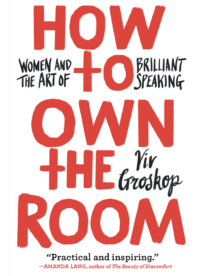
When it comes to public speaking, women are at a distinct disadvantage.
Too often women who speak up are not heard. Or listened to. That’s a problem.
For women to create the life and career they want they need to have effective speaking skills and be able to engage with their audience. In this book, Viv Groskop weighs in on how women specifically can hone their speaking skills.
Groskop is a writer, stand-up comedian, TV and radio host, and executive coach who helps women develop their leadership skills. Her book focuses on how women can be heard and remembered. Her argument is that audiences want the real you—not a plastic barbie or ken doll version of you. Your content is important, but Groskop argues that how you show up supersedes even what you say.
Groskop uses high-profile women such as Michelle Obama and Susan Cain—both excellent public speakers—as her examples. She goes beyond outlining their strengths to dissect, in depth, how they deliver powerful presentations.
Despite the title, this book is not just for women. Anyone can benefit from Groskop’s insights. This book will make you realize that no public speaker is perfect.
If you’re willing to be imperfect, you can own the room.
Nancy Duarte, Resonate: Present Visual Stories that Transform Audiences
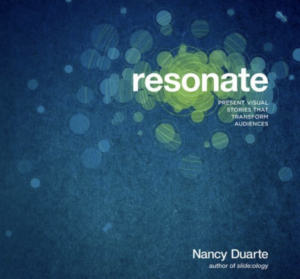
Nancy Duarte has decades of experience working in the presentation design space. She is the owner of Duarte Designs, which teaches leaders how to influence audiences through business storytelling. Duarte has worked with over half of the world’s top 50 brands.
Duarte’s book, Resonate, is for serious presenters committed to their craft.
Read this book if you are willing to dedicate the time it takes to be an excellent professional speaker. Applying passion and purpose to the concepts in her book will accelerate your career trajectory or social cause.
Similar to Groskop, Duarte walks you through case studies focused on impactful presenters such as Martha Graham and Martin Luther King. She breaks down how story is the key to compelling audiences. Duarte dives deep into the nuances of constructing a story, the importance of getting into the head of your audience, and how to deliver memorable moments.
This book is not a quick read with a few hacks to help you present better. Resonate is an in-depth book that provides insight into the world of delivering high-impact presentations. It’s a must-read for all serious public speakers.
Scott Berkun, Confessions of a Public Speaker
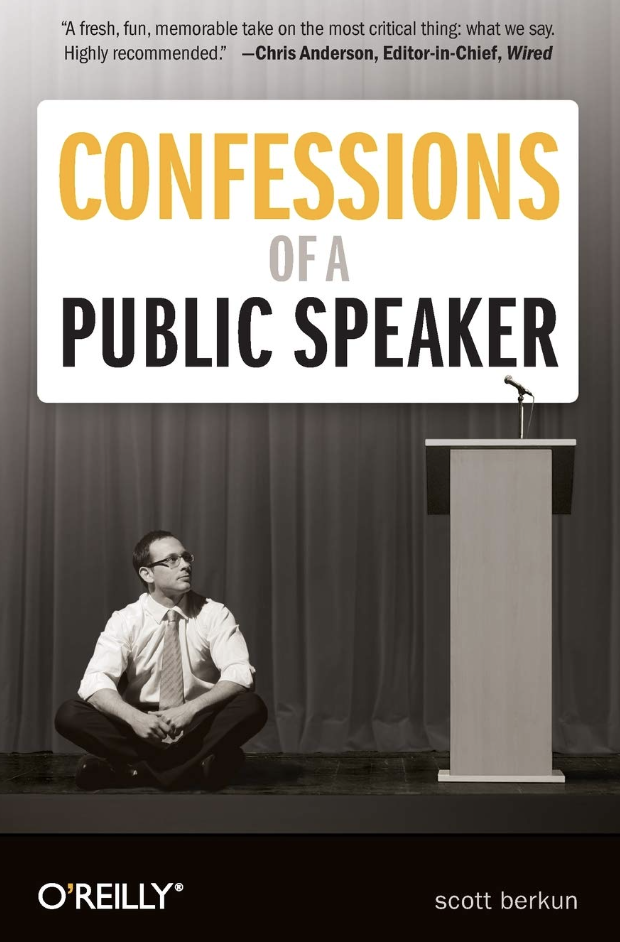
Want to be in the wings and watch a master keynote presenter speak? Then Scott Berkun’s Confessions of a Public Speaker is for you. You’ll feel what he’s feeling. You’ll have an insider’s view into what he’s thinking. Berkun’s stage experience is vast.
Berkun is funny. Also brutally honest. Take yourself too seriously? Well, don’t bother. While you chastise yourself for your mistakes your audience likely won’t notice.
Do you suffer from presentation anxiety? Get over yourself because most everyone does.
Think you don’t need to practice? Think again.
What I like about Berkun’s book is that he takes it on the chin himself, admitting when he has delivered poorly and analyzing what he needed to do to improve upon for his next keynote speech—presenting with power, using a deliberate rhythm, and learning how to hold attention.
Berkun’s book is relatable and would be valuable for just about everyone looking to improve their public speaking skills—novice to advanced public speakers will all find inspiration in this book.
Dale Carnegie, Public Speaking for Success

I’m confident that if you have even the slightest interest in public speaking you’re familiar with Dale Carnegie from his well-known book How to Win Friends and Influence People.
Carnegie was a man ahead of his time in the coaching space. He wrote a number of leadership skill primers, including books specifically on public speaking. Public Speaking for Success was first published in 1926 and was updated in 2006 by his colleague Arthur Pell. It’s still relevant today. It’s an easy read.
Carnegie’s premise is that most people are anxious about public speaking and block opportunities for themselves. As I tell my own clients, the key to overcoming your fears is to tune into your deep desire and (whatever your motivation) be driven. It’s possible to “flip the switch” on how your body and mind react, and this can make public speaking enjoyable, even for people who don’t consider themselves as such. It’s mindset. Your ability to be and feel confident will turn the corner on your anxiety.
Carnegie’s Public Speaking for Success is ideal for speakers whose native language is not English. Carnegie includes many often mispronounced and misused words (even by native English speakers) to help increase communication skills.
One of Carnegie’s concepts which I fully endorse to invest the time needed to create a presentation. Great presentations are not crafted on a scrap of paper in a few minutes. Carnegie gives advice on how to get yourself into a relaxed state of mind to percolate ideas.
Carnegie’s book is suited to all levels of public speaking but is particularly helpful for people at the beginning stages of planning a speech, feeling stuck, and want to get unstuck.
Mike Acker, Speak With No Fear
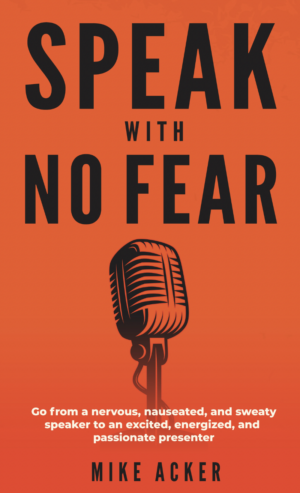
Mike Acker begins his book with this thoughtful quote from Mark Twain
Courage is not the absence of fear but the mastery of it.
I agree. Public speaking anxiety can be managed, but never erased.
Despite the title, this book will not teach you to eradicate anxiety. But if you want to learn how to regulate your nerves then do read this book. It includes lots of good insights on how to tame your public speaking anxiety, which is what the real goal should be.
One of the most powerful lessons in the book is Acker’s nuanced explanation of the difference between acting vs public speaking.
Here’s my paraphrase of his advice on this topic:
Trying to be in character while delivering a speech/presentation is a recipe for disaster. You are not a comedian or actor. Your job is to authentically share your thoughts, ideas, or perceptions. The weight is too heavy for you to carry when you pretend to be someone else (even if it is your belief of what the avatar of a good speaker is).
This message resonated with me and aligns with my experience. Many clients come to me with a goal of wanting to speak like [insert famous public speaker here]. I have to tell them that public speaking isn’t acting. It’s not possible to speak like someone else. You need to find your own voice and you’ll truly only ever connect with your audience when you are simply you.
This book is for those who want to learn the simple actions or nuances to increase their public speaking skills but realize that simple actions actually are deeply steeped in experience and theory.
Carmine Gallo, Talk Like TED
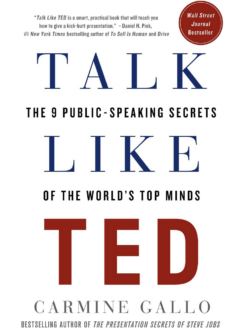
I wanted to like this book.
I greatly respect Carmine Gallo. I’m a fan of his work.
But this book was a bit of a tough read. It’s similar to a movie with too many characters and storylines that go down rabbit holes. It’s hard to follow the plot.
Gallo introduces a flood of TED Talk speakers as positive examples of public speaking techniques such as managing anxiety, storytelling, and deliberate body language. So, if what you’re looking for is learning through affirming examples from others’ positive experiences this book might be a good fit for you.
But my point of view (and this aligns with the research) is that we have a better opportunity to learn when we view weak or poor examples and then critique from a lens of how to improve. Gallo’s basic premise fails by speaking to, for the most part, only positive examples.
A strength of Talk Like TED is that it does a solid job of providing insights into the mechanics and nuances of specific public speaking techniques (character and story overwhelm aside).
One technique that Gallo shares, which most speech coaches agree with, is how to connect and persuade your audience through stories. Most everyone knows stories pull us in and help us connect the dots. They help us understand. Gallo argues that, more often than not, stories beat logic. It’s a hard sell, but his reasoning is convincing. Mind-melding (syncing between the speaker and the audience) happens when the storyteller and receiver share the experience of a well-constructed story.
Gallo’s suggestions about humour are helpful for public speakers who are cautious to deliver jokes. He suggests taking the pressure off and deflecting the attention by using funny yet relevant images or videos.
Gallo also speaks to the correlation between impact of a speech and the audience’s perception that the speaker was passionate about the topic. He recommends determining what you are passionate about and then digging a little deeper. That is where the gold is. As he says, when you dig deeper it “makes the heart sing” and that “creates magic between you and your audience.”
For some, this book will make their heart sing. For others, it won’t.
Chip Health and Dan Heath, Made to Stick: Why Some Ideas Stick and Others Die

When I did my communication degree, Made to Stick by Chip Heath and Dan Heath was required reading. This book is still one of my favourites. It was the most useful book I’ve ever been required to buy. Grounded in research on audience analysis, Made to Stick provides practical insight into the “how to” of creating understandable, influential, and memorable speeches.
Made to Stick is based on 6 principles demonstrated through the mnemonic SUCCES.
The first principle is Simplicity. Simplicity means getting to the core of a message. Simplicity is what makes messages sticky. When you over-explain, the message gets lost in the details. It’s not about dumbing down your idea(s). It’s about providing the least amount of information you can while maintaining clarity.
The second principle is Unexpectedness. We’ve all attended presentations where we quickly lose interest because the presenter delivers “blah” information. Purely informative speeches don’t engage us.
But brains wake up and take notice when prodded by something unexpected. Unexpectedness is often used at the beginning of a presentation because it has the power to hook the audience in.
The third principle is Concreteness. Experts often fall into the trap of not being concrete. This is caused by the “curse of knowledge” in which they provide more detail than a lay person needs to know or can handle. To give a simple example, a mixture of salt and water can save a child from dehydration. All the facts and figures about dose composition that a doctor might want to provide gives more information than most people need. Concreteness is relative. How concrete you need to be depends on your audience.
The fourth principle is Credibility. Demonstrating credibility when you don’t have what would be traditionally thought of as being credible is the art of communication techniques. Please understand that I’m not talking about manipulating facts or not telling the truth. Credibility can be shown in any number of ways, including anti-authority (showcasing someone who is suffering from a lifestyle choice that grabbing the super size bag of chips isn’t in their best interest) or testable credibility such as Wendy’s claim they had more beef than bun when compared to their competitors.
In the world of public speaking the fifth principle, Emotions, are often used to convince an audience. People are more likely to be persuaded by emotions than facts and figures. Using emotion artfully makes messages stick. It’s an audience-focussed technique, which is why it works.
The sixth principle is Stories. Stories help us connect the dots between the facts and how they play out. When you tell a story you invite the listener into the theatre of your mind. This creates connection. Each of these public speaking books speaks about stories and storytelling, and for good reason. Effective storytelling is one of the best ways you can influence and engage your audience.
Made to Stick is for everyone—from novice to seasoned public speakers. The Heath brothers lay out numerous concepts of how to make your ideas stick and be talked about for days.
There are lots of books on public speaking, but these are the best ones.
But don’t just read them.
Practice the techniques. These books will show you the way to becoming the powerful public speaker you want to be. But you have to do the work.

